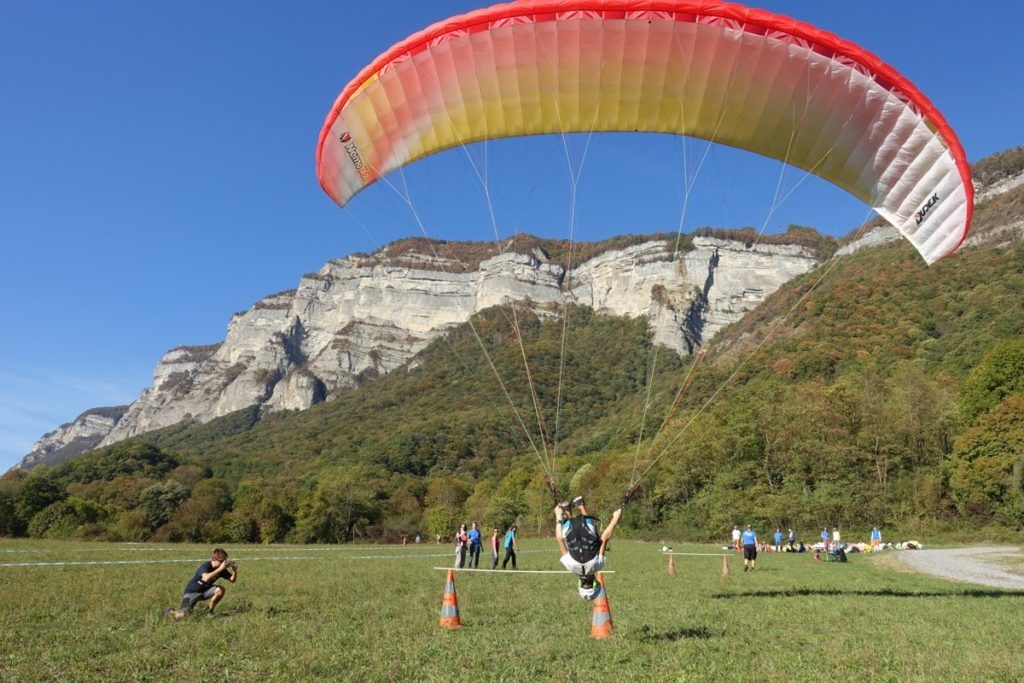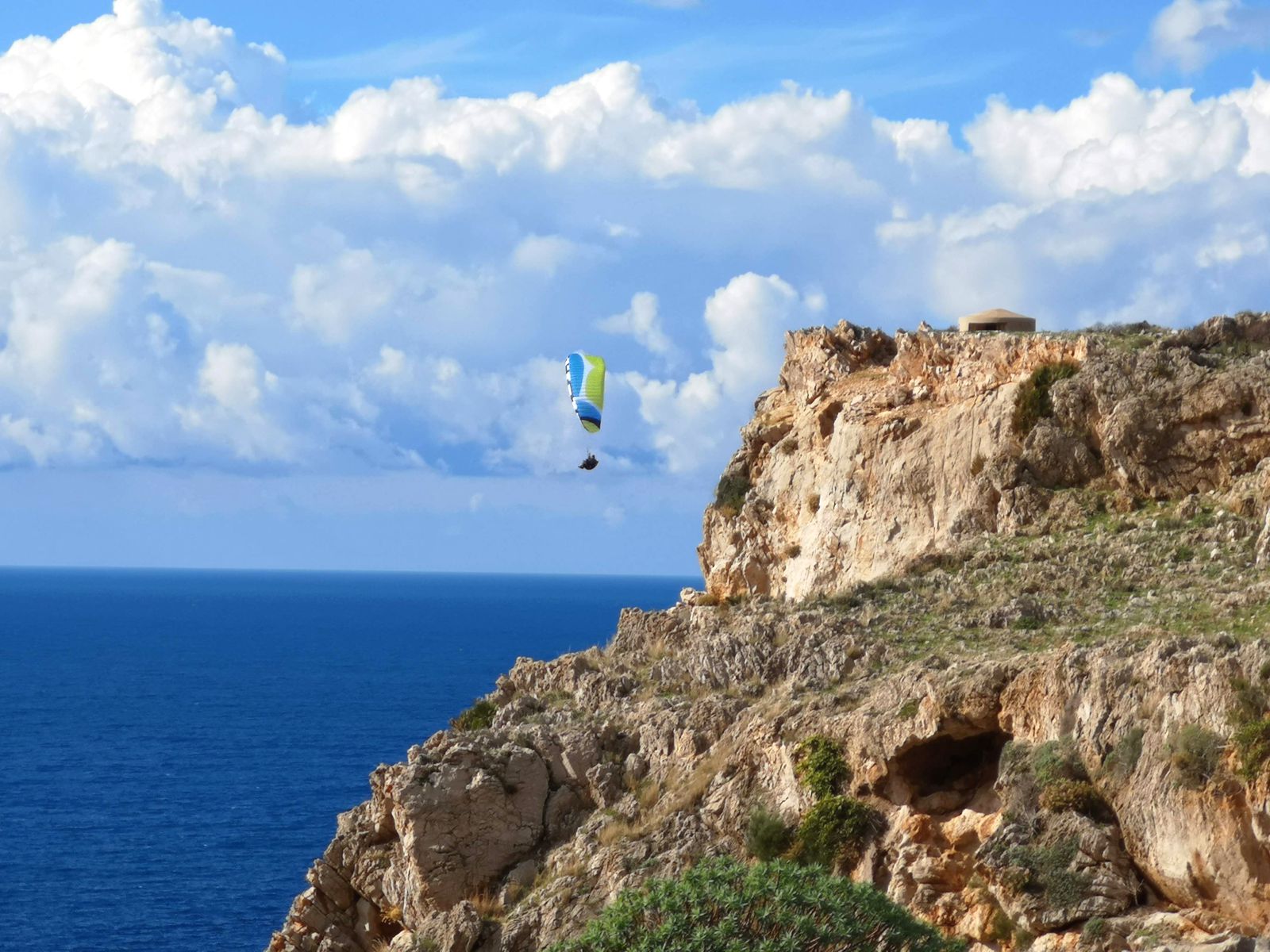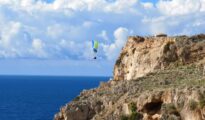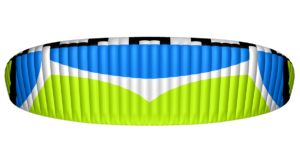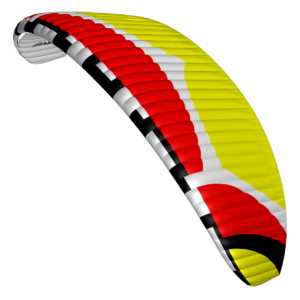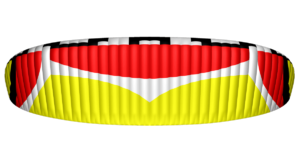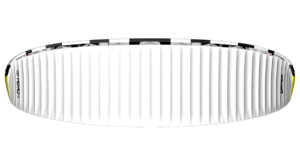Nemo 4
Nemo 4
Nemo 4 is recommended as your first purchase after initial training, the more so if your school used it. There is still a lot of its capabilities you will be able to discover, while staying satisfied with its safety, performance and versatility in various forms of recreative flying.
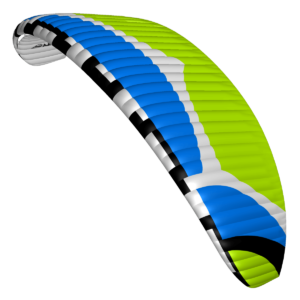
Whats new?
The most obvious change in the new Nemo 4 is its look. This is the first paraglider featuring new colour sets called Three Moods – Harmony, Energy, Passion.
On the request of paragliding instructors we are extending by 5 kg up the EN/LTF loads of two most popular sizes: the 23 up to 55-80 kg, and the 25 up to 70-95 kg. This small change will make completing the equipment for a paragliding school much easier.
The other small changes are: return to 100% of the Edelrid lines in the rigging, change of colours in some of the lines, adjusting the production cycle to cutting edge technologies used in our plant.
 See movie
See movie
Design and purpose
Nemo 4 is a certified fun paraglider of EN A class, with modern design, good performance and great safety. It is distinguished from earlier Nemo by better glide ratio, agility and even easier launch. It is dedicated for the beginners and recently trained pilots – it can be used for training, winching and paramotoring.
The three-row canopy with rigid rods (Dudek FlexiEdge technology) incorporates current experience won while designing and testing three- and two-row prototypes of high performance paragliders.
Inner reinforcements, structural rods and mini-ribs make sure that the aerofoil is precisely reproduced and stabilized in flight. Three-row rigging of reduced drag increases performance. Mini-ribs on the trailing edge make for slim canopy with minimal ballooning and improved airstream. All those solutions result in exceptional performance in its class, still fullfilling the harsh requirements of EN-A class safety (as so-called “upper A”).
When designing Nemo 4 we put a lot of work into flight safety, effective steering, easy operation and attractive look of the paraglider. Advanced engineering merged with Piotr Dudek years of designer experience resulted in a paraglider of perfectly stabilized canopy, ideally suited to pilot’s expectations of this class.
Certification
All sizes have passed the certification procedures, receiving EN/LTF A category.
The EN and LTF certificates remain valid only when the trimmers are closed AND the trimmer loop is hooked on the main carabiner. In this way the risers stay fixed at their standard lengths and trimmer adjustment in flight is not possible.
When the trimmer straps become unlocked, making the trimmer adjustments possible, the canopy has an ULM (DGAC) flight attest.
Launch
The launch is pretty easy, with some practice it is not necessary to keep the risers up, as the canopy comes up on its own and waits for you in the nadir.
Steering
Nemo 4 is a responsive and agile wing, smoothly reacting to all pilot’s actions. Steering is light and pleasant, with steering forces growing proportionally to brake input. Adding some weightshifting makes the turns faster and tighter.
Design solutions
- Nemo 4 is made with Flexi-Egde technology. The rods make the leading edge stiffer and smoother, improving the launch protecting the canopy against deformations at high speeds.
- Inner reinforcements, structural rods and mini-ribs make sure that the aerofoil is precisely reproduced and stabilized in flight. Three-row rigging of reduced drag increases performance.
- Mini-ribs on the trailing edge make for slim canopy with minimal ballooning and improved airstream.
- CSG (Canopy Shape Guard)
- DOA (Dudek Optimized Airfoil).
- Nemo 4 is manufactured in new technology, using precise laser plotter.
The whole production process takes place in Poland under watchful eye of the designer himself, ensuring highest European quality.
Careful selection of the modern cloth and design ideas made sure the Nemo 4 will have great durability. All materials used come from numbered batches, and each production stage can be verified down to identification of individual worker and supervisor.
Main lines are coded with colours according to recent PMA recommendations. More about this initiative on the Association website.
Design solutions, technologies and other functionalities are listed below in the Technologies section.
Construction solutions
Technologies, concepts
Risers functionality
Used solutions
Parameters
Weight ranges

TECHNICAL DATA
| Nemo 4 – size | 20 | 23 | 25 | 28 | 31 |
| Certificate EN/LTF | A | A | A |
A |
A |
| Approval – identification ULM | pending | yes | yes | pending | pending |
| Number of cells | 42 | 42 | 42 | 42 | 42 |
| Surface flat [m2] | 20.60 | 23.00 | 25.30 | 28.00 | 31.00 |
| Surface projected [m2] | 17.52 | 19.56 | 21.52 | 23.82 | 26.37 |
| Wingspan flat [m] | 10.20 | 10.78 | 11.30 | 11.89 | 12.51 |
| Wingspan projected [m] | 8.00 | 8.46 | 8.87 | 9.33 | 9.82 |
| Aspect ratio flat/projected | 5.05 / 3.65 | ||||
| Sink [m/s] | min = 1.1 (+/- 0.1 m/s) | ||||
| Speed* [km/h] | trym = 37 +/- 2 ; max = 47 (+/- 2 km/h)* | ||||
| Longest chord [cm] | 249.80 | 264.00 | 276.90 | 291.30 | 306.50 |
| Shortest chord [cm] | 58.70 | 62.00 | 65.10 | 68.40 | 72.00 |
| Lines length (incl. risers) [m] | 6.17 | 6.52 | 6.84 | 7.19 | 7.57 |
| Total lines length [m] | 221.52 | 233.43 | 245.06 | 258.66 | 272.48 |
| Canopy weight [kg] | 4.21 | 4.58 | 4.92 | 5.33 | 5.74 |
| Take-off weight PG** [kg] | 48-72** | 55-80** | 70-95** | 85-110** | 100-135** |
| Take-off weight PPG/PPGG*** [kg] | 45-85*** | 55-95*** | 70-110*** | 85-130*** | 100-155*** |
| Distance between risers [cm] | 40 | 42 | 44 | 46 | 48 |
| Maximum symmetric control travel at maximum weight in flight [cm] |
55 | 55 | 60 | 60 | 65 |
| Lines | Edelrid Technora: 1,2 & 1,3 & 1,5 & 1,8 & 2,3 | ||||
| Cloth | Porcher 38, Dominicotex 34 | ||||
* Speeds are given as estimated for the middle wing size and the middle of its weight range. These speeds can vary within +/- 2 km/h depending on the size, take-off weight and additional factors such as air pressure and temperature.
** The basic rule is to choose the size of the wing so that the take-off weight is in the middle of the weight range. Less weight on the wing (lower range take-off weight) can be considered for foot take-off, when flying in calmer conditions, or when we want to improve economy. More experienced pilots who want to fly dynamically, have higher speed and fly in more demanding wind conditions can consider greater wing loading (take-off weight in the upper range). This is a common option among trike users.
*** Note – the canopy significantly changes its behavior with increasing wing loading. The greater the loads, the greater skill and concentration of the pilot are required.



